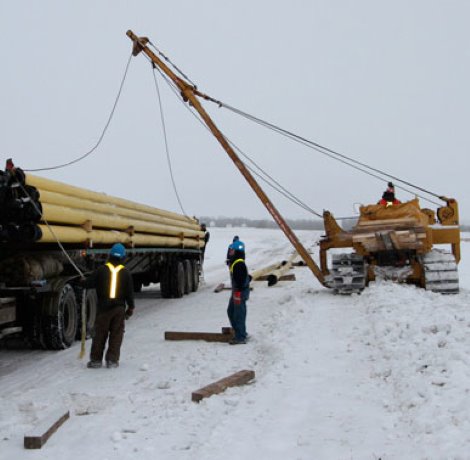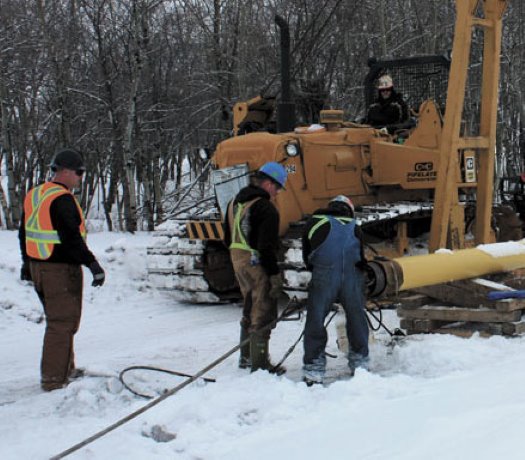TransGas, a subsidiary of SaskEnergy, is battling extreme winter conditions to complete the construction of a transmission pipeline, which will transport a new supply of natural gas to customers from the province’s oil-rich Bakken region.TransGas is undertaking the construction of a $29 million pipeline that will stretch 117 kilometres from Alameda to Whitewood, Saskatchewan.
“Initially, with all the snow and the wet conditions, the ground didn’t freeze,” said Dale Ziegler, corporate mainline pipeline manager with Carson Energy Services Ltd. “So, we had very muddy conditions under the snow. We were struggling at the beginning with no frost.”
TransGas is undertaking the construction of a $29 million pipeline that will stretch 117 kilometres from Alameda to Whitewood, Saskatchewan.
Workers with Lampman-based Carson Energy are working in weather conditions that include water, mud, snow, ice, wind and extremely low temperatures.
“The snow was cleared off to enable the ground to freeze deep enough, so we could travel and work on the right of way,” said Ziegler.
“When the snow was cleared, we had the problem of too much frost. “
The large amount of rain that fell in southeast Saskatchewan this fall created wet and muddy conditions.
However, when it did freeze, the ground became harder than expected because it was saturated with water.
For this reason, it has been more difficult to clear the right of way for the pipeline, dig the trench, weld the pipe, put the pipe in the ground and put back the fill.
Despite this, Carson Energy has completed the right of way and all the pipe has been put in the ground.
“We have strung out all the pipe and bent it for hills or to match the terrain,” said Ziegler. “The next step is welding. We have two welding crews out there going full out.”
These crews are dealing with extreme wind and snow with snow blowers, graders, skid steers, bobcats and lots of shovels.
“The welding is done on the ground and we try to keep the crews as tight as possible,” he said.
“What we trench, we do on the same day. The clay is put back in place over the ditch line, but right now its just frozen lumps. We have to come back in spring to do all the clean up, which includes returning and compacting the top soil.”
The wet conditions have also made it necessary to directionally drill under slough and wet areas.
“The biggest issue from an environmental point of view is staying on the survey right of way,” said Ziegler. “If water is in our way, we have to bore under it.”
He said the sections of pipe are pulled under wet areas and then tied in to the pipeline.
A lot more boring has been done than was initially expected.
At peak construction, Carson Energy had about 160 workers spread along the entire length of the pipeline. TransGas has a chief inspector and about 10 other inspectors working on the project.
Consultants working on the project include: Golder and Associates (environmental), Altus Geomatics (surveying), AM Inspection (radiographic) and Black Box IDC (weld mapping).
Construction of the 10 inch pipeline started in September and is scheduled for completion on June 1, 2011.
Once completed, the Alameda to Whitewood will transport gas that has been captured and processed by oil companies.
“The driver behind this project is the oil that is being produced by the Bakken oil play,” said Brian Torgunrud, executive director of engineering and technology with TransGas.
“Because a lot of oil is being produced, there is a lot of associated gas.”
Associated gas is natural gas extracted during the development of oil reserves.
“When gas comes up with the oil, it runs through a gas plant to strip out other pipeline liquids, such as butane and propane.”
If pipeline capacity is unavailable or too far from existing natural gas infrastructure, oil producers must flare or burn off excess natural gas, resulting in greenhouse gas emissions.
Dustin Duncan, minister responsible for SaskEnergy, said this pipeline’s peak capacity will reduce CO2 levels from natural gas flaring by the equivalent of annual emissions produced by heating 105,000 homes in Saskatchewan.
This represents every household in Saskatoon and Regina.
The Bakken play is expected to provide years of crude oil and natural gas production.
“The Alameda-Whitewood pipeline taps into an important long-term natural gas supply that will be used to fuel Saskatchewan’s growing economy,” said Duncan.
Proposed provincial government regulations will make it necessary for oil producers to capture more associated gas.

TransGas workers load sections of pipe onto a truck in extremely cold Saskatchewan weather.



Recent Comments
comments for this post are closed